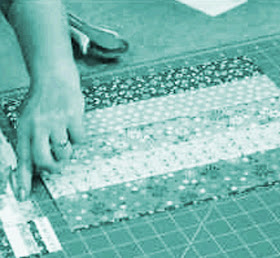Quilt #1. Four Patch Strip Quilt, about 1830,
from Penelope Tucker's collection.
If you do an image web search for the words Vintage Strip Quilt
many different styles come up.
Below is a common style we call a strip quilt.
Quilt #2 About 1940
So a strip quilt is a quilt of blocks pieced in strips.
Quilt # 3 Date?
Quilt # 4 1870-1900
Or is a strip quilt a set for blocks...
Quilt # 5 1880-1920
Blocks of any kind?
#6 Rotary cutting strips pieced together.
Or is a strip quilt any pattern pieced efficiently by cutting strips, stitching them together and then cutting across them?
Quilt #7 Lissa Alexander's strip-pieced
Lone Star for McCall's Quilting.
#8 All in a Row, 24 Row-by-Row Quilt Designs
And what is the difference between a strip quilt and a row quilt?
Quilt #9 Double Four Patch set with chintz, 1810-1830
Except that traditional strip-set quilts are usually hung with the strips vertical. (The antique above with its cut-out corners seems to have been planned that direction.)
And today's Row Quilts are designed with horizontal rows.
Just wondering. You guys got any thoughts?













To me, a strip quilt is like #1, #4, #5 and #9. I call #2 & #3 string quilts, and #8 and the last photo a row quilt
ReplyDeleteI've never thought of quilts using strip piecing methods as strip quilts.
Any quilt with columns of vertical blocks of any method, separated by vertical columns of fabric(s) or different blocks is a strip quilt to me. It's the vertical layout and the separating columns that are the keys in my mind.
I suppose this is how so much confusion arises and makes historians' work interesting when results & methods with very similar names are intermixed.
When I think of strip quilts, I think of vertical rows alternating between a single fabric and a vertical row of blocks. I guess I think very traditionally. However, I think that all of the quilts in your article qualify.
ReplyDeleteI'm in the #1, #4, #5 & #9 camp, too. Strip quilts, or strippy quilts feature vertical rows of pieced blocks and unpieced fabric strips. Examples 2 & 3 are always string quilts to me. Strings, as in made with strings of fabric left over from other projects which are too narrow to be easily pieced. At least that's what I was taught way back in the day when I first learned to make string quilts. Of course, being a fairly new quilter at the time, I had to make lots of strings from new fabric in order to make a string quilt!
ReplyDeleteI agree with the gang -- strip quilts have a vertical block layout with separating fabric sashes, string quilts are a particular method of piecing blocks.
ReplyDeleteMay I modify my comment? I just recalled that I've seen Amish(?) quilts that had no blocks, only columns of fabrics separated by a different fabric. I'd consider them in the strip quilt family also.
ReplyDeleteStrip versus String?????
ReplyDeleteIda know. When I think of strip quilts, I do think of quilts like the first or fourth one, but also things like Amish Bars. All the other things DO fit a definition of strip, and I'm willing to let the term expand, but I'll still think more traditionally, I'm sure! Let's look back in 20 years and check on this. If we're still here quilting. =)
ReplyDeleteThen you have the strings pieced and set in vertical columns named Chinese Coins. Basically, I agree with the majority here that blocks set in vertical rows with vertical strips or sashes of fabric between the rows of blocks is a strip set quilt. Then if put in horizontal rows, with or without sashing it becomes a row quilt. You can do all kinds of blocks and settings with your strings.
ReplyDeleteWhen I think of a strip (or strippy as we call them here) quilt I think of vertical pieced or appliqued strips set with vertical strips of fabric. Quilts made up of small strips, I think of as string quilts. We see lots of early (pre 1840) strippy quilts here in Maine. Very often they have cutout corners. I guess that is why I love the strippy setting so much.
ReplyDelete